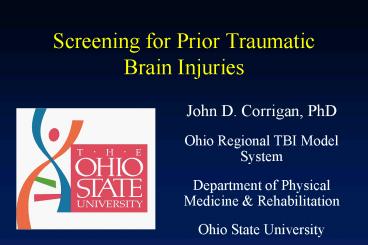Screening for Prior Traumatic Brain Injuries - PowerPoint PPT Presentation
1 / 21
Title:
Screening for Prior Traumatic Brain Injuries
Description:
Clients in Treatment for Substance Abuse. and Severe Mental Illness (N=50) ... Part 1: Report on lifetime blows to head in various situations (e.g., MVAs, ... – PowerPoint PPT presentation
Number of Views:51
Avg rating:3.0/5.0
Title: Screening for Prior Traumatic Brain Injuries
1
Screening for Prior TraumaticBrain Injuries
- John D. Corrigan, PhD
- Ohio Regional TBI Model System
- Department of Physical Medicine Rehabilitation
- Ohio State University
2
Topics Addressed
- Why screen for a history of TBI?
- Methodological Issues in Screening
- Methods of Screening
- Conclusions
3
Why screen for/identify TBI?
- Determine prevalence
4
Rates of TBI in Prison Studies
5
Why screen for/identify TBI?
- Determine prevalence
- Conduct cohort studies
6
Clients in Treatment for Substance Abuse and
Severe Mental Illness (N50)
7
(No Transcript)
8
(No Transcript)
9
Why screen for/identify TBI?
- Determine prevalence
- Conduct cohort studies
- Inform intervention
10
TBI and Substance Use Disorders among Minnesota
State Prisoners (N998)
11
Symptoms past 12 months of Clients Admitted for
Substance Abuse Treatment in Kentucky (N7,932)
12
Issues in Screening/Identification
- Biomarkersonly prospects to date lifetime
exposure will be very difficult - Capture from medical treatment
- Only as good as the diagnosis recorded (Powell et
al, 2008) - Medical treatment may not be sought
- Self-report
- Not aware of injury
- Do not recall injuries (telescoping, poor
memory) - Cannot self-diagnose
- Issues biasing disclosure (secondary gain, stigma)
13
Challenges Determining the Validity
ofSelf-reported Lifetime History
- No gold standard
- In lieu of sensitivity specificity, how can
validity be determined? - Self-administered screens compared to results of
clinical interview - Findings compared from different cohorts
- Summary indices derived for which reliability and
predictive validity are determined
14
Methods of Screening
- TBI-TAC identified 20 different tools being used
- VA mild TBI screening process
- DVBIC Brief TBI Screen (BTBIS Schwab et al.)
- TBI Questionnaire (TBIQ Diamond et al.)
- Brain Injury Screening Questionnaire (BISQ
Gordon et al.) - OSU TBI Identification Method (OSU TBI-ID
Corrigan Bogner)
15
(No Transcript)
16
Brain Injury Screening Questionnaire (BISQ)
- Part 1 Report on lifetime blows to head in
various situations (e.g., MVAs, falls, assaults)
and losses of consciousness or alterations in
mental state - Part 2 Frequency of 100 functional problems
commonly observed after TBI (physical, cognitive,
emotional/behavioral) - Part 3 Issues other than BI that may account for
symptoms reported (e.g., developmental
difficulties, psychiatric history, medications)
17
BISQ (continued)
- Paper and online versions (5-20 minutes)
- Originally validated by Gordon et al., 2000 25
items found to be sensitive and specific to TBI.
- Has been used in pediatric, substance abuse and
homeless populations (Cantor et al., 2004, 2006
Fenske et al., unpublished manuscript) - New CDC-funded validation study under way to
examine BISQ items that are sensitive and
specific to TBI, compared to other populations
with cognitive problems (i.e., chronic pain,
long-term depression)
18
OSU TBI Identification Method
- Structured interview designed to elicit lifetime
history of TBI - Uses multiple probes to stimulate memory
- Avoids misunderstanding about what a TBI is by
first eliciting injuries, then determining if
altered consciousness occurred as a result - Provides richer information about history than
simple yes/no (e.g., number, severity, effects,
timing, etc.)
19
OSU TBI Identification Method (contd)
- Summary indices of lifetime exposure to TBI have
demonstrated both inter-rater and test/re-test
reliability. - Criterion-related validity demonstrated in two
studiessummary indices, when combined with other
indicators of cerebral compromise, are
significant predictors of cognitive performance,
symptomology and behaviors associated with
frontal lobe dysfunction.
20
Issues Identified from Structured Interviews
- General public has limited understanding of
altered consciousness - Spurring recall multiple ways is essential
- Multiple mild injuries require special attention
- Alcohol blackouts and anoxic events need to be
distinguished from loss of consciousness - Knowledge of childhood injuries is incomplete
not sure about extent of altered consciousness,
completely unaware of injuries before age 5
21
Conclusions
- Screening/identification of lifetime TBI is being
done in both clinical and research settingsbut
is not being done well. - Structured interview by an informed interviewer
is the current gold standard. - One- or two-item screeners of questionable
validity. - Self-administered methods in general have to be
looked at with skepticism. - Research needed to improve our methods.































